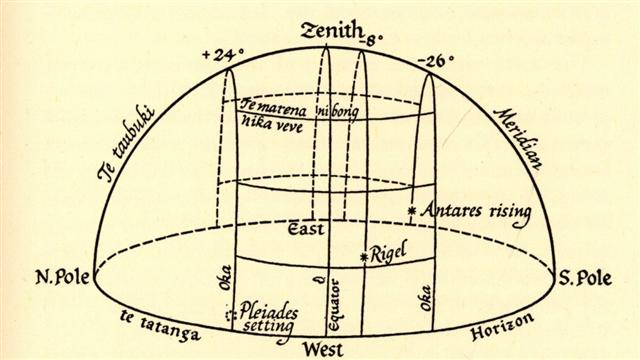3. When Sun in spring moves gradually higher in the sky he is not alone - the whole sky dome is rising together with him. To perceive Sun climbing it is therefore best to stepwise change the point of reference from one heliacally rising star to another. Each new such star comes up through another hole (has another declination). The beams of light from these stars (the 'rungs' in the 'sky ladder') can be likened to beams of wood (wherein fire lies dormant). ... Ira got up, climbed up, went on, and reached Ruhi Hepii. He drilled a hole into the stone. After the hole was deep enough, he took the ornament (rei) and put it into the hole so that the shiny side (rapa) was turned outward. He gave the place the name 'Ruhi Hepii' ... When Ira drilled holes in stones it was just the same as when people drilled holes in the stones which were arranged into the oval foundations of their houses. By inserting a shiny object inside he created a beam of light possible to observe from the right direction. As to the meaning of the place name Ruhi Hepii we have already briefly discussed Ruhi, and I guess Hepii can be read as he piki:
Together with my earlier guess for Ruhi being a name of Rigel (in zenith around winter solstice, a time of 'languor') the name Ruhi Hepii suggests the first 'rung' on the ladder (pikiga), which will carry the climbing (hakapiki) Spring Sun ('the cat', cfr piki-a-fare) high up to summer solstice. In the rongorongo texts such a first 'rung' could be connected with manu kake (the climbing bird), as for instance in Ga4-21:
We can now appreciate the number at vaha kai (Gb5-10) better, because it not only puts fire (5) in conjunction with the station of renewal for Sun (10), but 5 * 10 = 50 is also equal to the dimension of the broad central band of the Gilbertese sky dome:
Though there probably is a difference in meaning between kake and piki:
Perhaps the correct term for ascending in the night is kake in contrast to piki for ascent during daytime. Heliacally rising stars cannot be seen because the rays from Sun makes it impossible. What star is rising heliacally is instead deduced from the night sky which shows another star positioned halfway around the sky globe, and this night star should be watched for at the proper time in the evening when it is rising in the east. |
||||||||||||||||||

